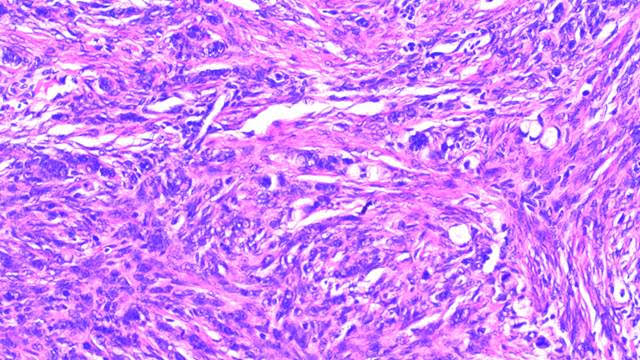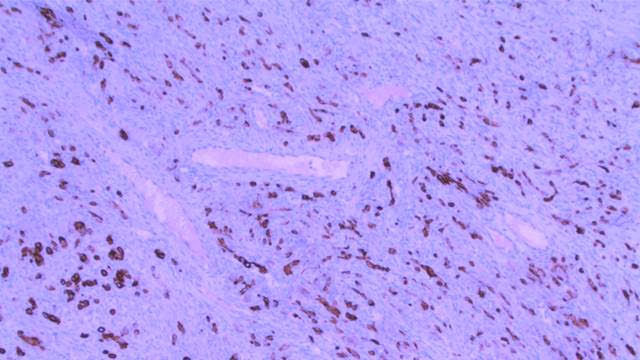Monday Poster Session
Category: Colon
P2486 - An Atypical Presentation of a Unilateral Krukenberg Tumor of Colonic Origin in a Postmenopausal Woman
Monday, October 27, 2025
10:30 AM - 4:00 PM PDT
Location: Exhibit Hall

Deannys Batista, MD
Aventura Hospital
Miami, FL
Presenting Author(s)
Deannys Batista, MD, Solomon Lerer, MD
Aventura Hospital, Miami, FL
Introduction: Krukenberg tumors (KTs) are metastatic ovarian tumors characterized by mucus-filled signet ring cells and stromal involvement. While they usually arise from gastric carcinoma, they can also originate from other mucinous tumors, including colorectal cancer (11% of cases). KTs primarily affect young, premenopausal women, often with bilateral ovarian involvement. Unilateral cases (~3-8%) typically involve the right ovary, possibly due to its more frequent ovulation, larger right paracolic gutter, and greater abdominal fluid drainage. Immunohistochemistry is essential for distinguishing primary from metastatic tumors. We report a case of a postmenopausal woman presenting with a unilateral ovarian mass consistent with a KT of colonic origin.
Case Description/
Methods: A 72-year-old woman with no prior gynecologic or GI history presented with nausea, vomiting, abdominal pain and distension, anorexia, and a 30 lb weight loss over two months. She denied vaginal or rectal bleeding, tobacco use, or a family history of cancer. She had never undergone a colonoscopy. Labs showed elevated CA 19-9 (282) and CA-125 (991), and CEA within normal limits. Physical exam revealed abdominal distension with a fluid wave, but no palpable masses. CT of the abdomen showed a complex cystic 8 cm right adnexal mass and large-volume ascites. Paracentesis yielded 6.7 L of dark brown fluid; cytology was negative and SAAG suggested malignancy. Exploratory laparoscopy revealed diffuse intra-abdominal disease including a necrotic right ovarian tumor involving the peritoneum, omental fixation to the transverse colon, and a small bowel conglomerate. EGD showed no evidence of gastric malignancy. Colonoscopy was deferred due to concern for pneumoperitoneum, as further insufflation was contraindicated. Pathology of the right ovary, fallopian tube, and periadnexal tissue revealed metastatic poorly differentiated adenocarcinoma with focal signet ring cells and lymphatic invasion. Tumor cells were positive for CK20 and CDX2, and negative for CA 19-9, CK7, ER, WT1, PAX8, and TTF-1, consistent with a KT of colonic origin. The patient's condition worsened, and she was discharged to hospice care.
Discussion: Krukenberg tumors are rare and carry a poor prognosis, especially when synchronous. Most are bilateral and occur in premenopausal women. This case highlights an unusual presentation in a postmenopausal woman with a unilateral ovarian tumor of colonic origin. Early recognition and diagnosis of KTs are crucial due to their aggressive course.

Figure: Right ovary: signet ring cell area.

Figure: Right ovary: CK20 positive immunostaining in signet ring cell area, highlighting the tumor cells.
Disclosures:
Deannys Batista indicated no relevant financial relationships.
Solomon Lerer indicated no relevant financial relationships.
Deannys Batista, MD, Solomon Lerer, MD. P2486 - An Atypical Presentation of a Unilateral Krukenberg Tumor of Colonic Origin in a Postmenopausal Woman, ACG 2025 Annual Scientific Meeting Abstracts. Phoenix, AZ: American College of Gastroenterology.
Aventura Hospital, Miami, FL
Introduction: Krukenberg tumors (KTs) are metastatic ovarian tumors characterized by mucus-filled signet ring cells and stromal involvement. While they usually arise from gastric carcinoma, they can also originate from other mucinous tumors, including colorectal cancer (11% of cases). KTs primarily affect young, premenopausal women, often with bilateral ovarian involvement. Unilateral cases (~3-8%) typically involve the right ovary, possibly due to its more frequent ovulation, larger right paracolic gutter, and greater abdominal fluid drainage. Immunohistochemistry is essential for distinguishing primary from metastatic tumors. We report a case of a postmenopausal woman presenting with a unilateral ovarian mass consistent with a KT of colonic origin.
Case Description/
Methods: A 72-year-old woman with no prior gynecologic or GI history presented with nausea, vomiting, abdominal pain and distension, anorexia, and a 30 lb weight loss over two months. She denied vaginal or rectal bleeding, tobacco use, or a family history of cancer. She had never undergone a colonoscopy. Labs showed elevated CA 19-9 (282) and CA-125 (991), and CEA within normal limits. Physical exam revealed abdominal distension with a fluid wave, but no palpable masses. CT of the abdomen showed a complex cystic 8 cm right adnexal mass and large-volume ascites. Paracentesis yielded 6.7 L of dark brown fluid; cytology was negative and SAAG suggested malignancy. Exploratory laparoscopy revealed diffuse intra-abdominal disease including a necrotic right ovarian tumor involving the peritoneum, omental fixation to the transverse colon, and a small bowel conglomerate. EGD showed no evidence of gastric malignancy. Colonoscopy was deferred due to concern for pneumoperitoneum, as further insufflation was contraindicated. Pathology of the right ovary, fallopian tube, and periadnexal tissue revealed metastatic poorly differentiated adenocarcinoma with focal signet ring cells and lymphatic invasion. Tumor cells were positive for CK20 and CDX2, and negative for CA 19-9, CK7, ER, WT1, PAX8, and TTF-1, consistent with a KT of colonic origin. The patient's condition worsened, and she was discharged to hospice care.
Discussion: Krukenberg tumors are rare and carry a poor prognosis, especially when synchronous. Most are bilateral and occur in premenopausal women. This case highlights an unusual presentation in a postmenopausal woman with a unilateral ovarian tumor of colonic origin. Early recognition and diagnosis of KTs are crucial due to their aggressive course.

Figure: Right ovary: signet ring cell area.

Figure: Right ovary: CK20 positive immunostaining in signet ring cell area, highlighting the tumor cells.
Disclosures:
Deannys Batista indicated no relevant financial relationships.
Solomon Lerer indicated no relevant financial relationships.
Deannys Batista, MD, Solomon Lerer, MD. P2486 - An Atypical Presentation of a Unilateral Krukenberg Tumor of Colonic Origin in a Postmenopausal Woman, ACG 2025 Annual Scientific Meeting Abstracts. Phoenix, AZ: American College of Gastroenterology.
